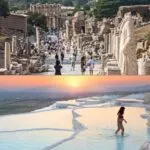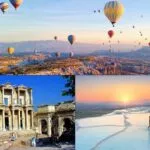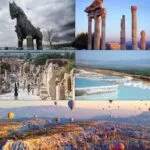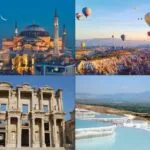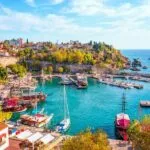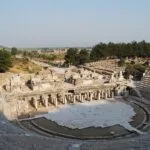Ancient city ruins in the Denizli region of Turkey, Pamukkale and Hierapolis are a UNESCO World Heritage site. Nicknamed “Cotton Castle” because of its solidified white calcium thermal pools on the side of a hill, along with the iconic Hierapolis buildings, they were the most visited tourist attraction in the country in 2014.
Sitting inland in an agricultural province, the last time I went to Pamukkale and Hierapolis was in 2002 but I didn’t fully absorb the meaning of the natural phenomenon, took no photographs and my memories became hazy over the years. However, I was always aware I never spoke about it on my blog and so I made a return visit in June of this year.
Arriving in Pamukkale
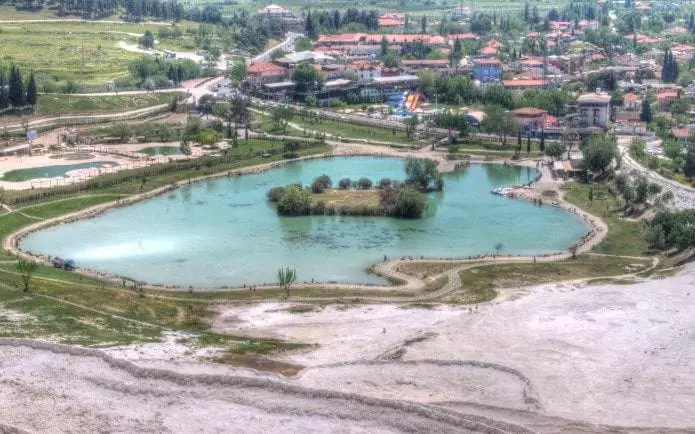
Most people make a day trip to Pamukkale from surrounding holiday resorts. Many walk by on their way to other locations for the night. I chose the latter as a way to split a long bus ride from Cappadocia and booked this way into a modern hotel in the outskirts because the closer the hotel is to the thermal pools, the more luxurious it is.
Walking around the village is an fascinating, comical glimpse into a culture that is desperate to make money from anyone who passes by. With local women wearing village clothes, herds of roosters wandering the streets and rusty farmyard equipment sitting in backyards, it’s definitely typical.
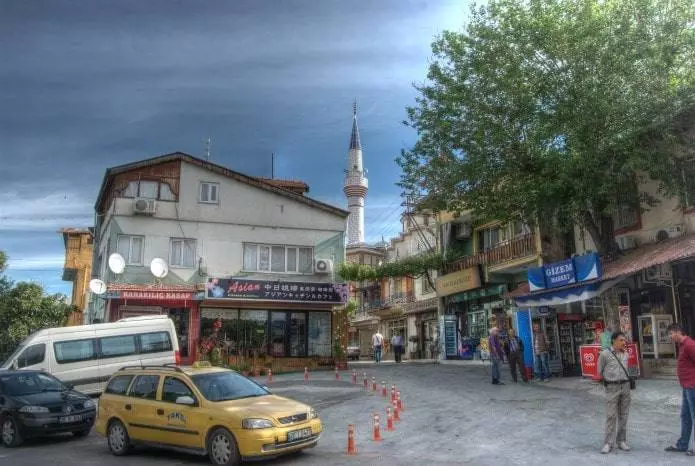
An old Cortina car whizzed every so often, followed by the latest Ford or Opal model, reflecting Turkey’s ad-hoc tendency to combine modern with the old. An Asian restaurant seemed to be very popular and then, of course, louder than life and brash ticket alls, selling tours and paragliding experiences.
If it had been my first time in Turkey, I would probably have bought anything because of the daunting and hard-core sales patter, but I chose to go it alone on this occasion instead. Despite the mishmash of old and new and overbearing ticket alluring, the village is charming and I felt safe as a single female. I was also pleased that I stayed overnight, as this helped me to explore more time.
Things to do at Hierapolis and Pamukkale
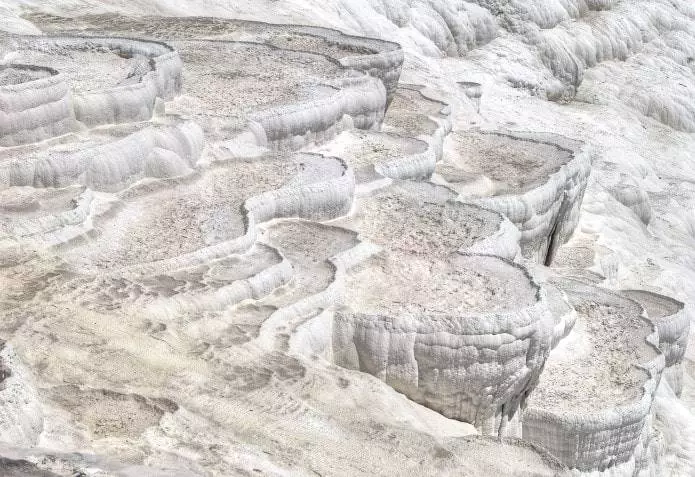
The Ancient Ruins of Hierapolis
The Thermal Pools
Cleopatra’s Pool
The Pamukkale Museum
Ancient Hierapolis City Ruins
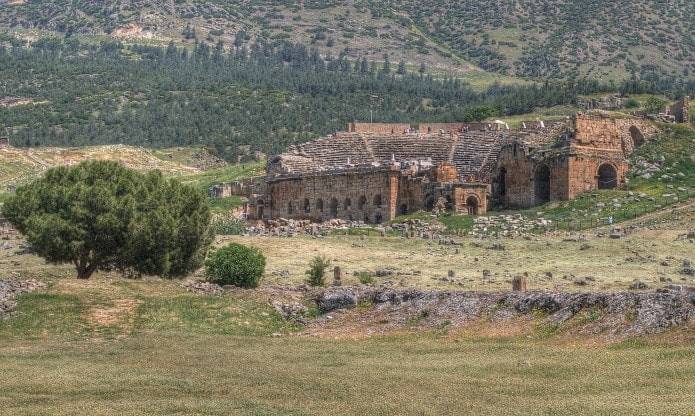
Looking at the map, I realized that in Hierapolis, whose roots date from the 2nd century BC, I would not be able to walk around everywhere. The name meaning “sacred city” reflected its vast temple masses but instead most of the ruins date from the Roman era and are spread over a wide distance. The only place I wanted to see in reality anyway was the big theater that was reached by a strenuous walk up a little hill. Walking around in the heat of the midday often has that effect.
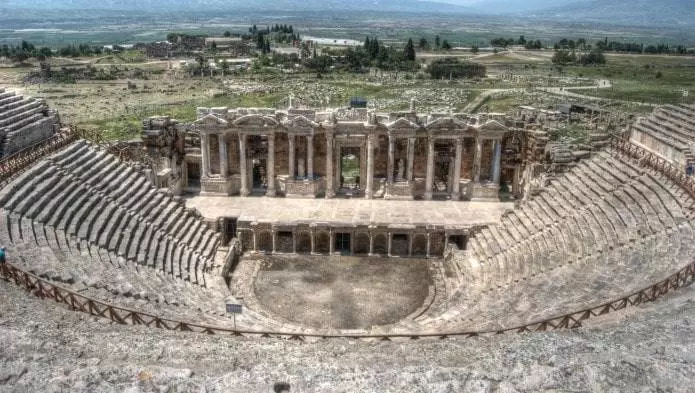
I walked in through the back entrance, and sat down for about 20 minutes at the top step. The impressive front façade was blocked off by a barrier but behind it was a stunning view of the landscape far into the distance. Truly, I think that this ancient theater is better than Ephesus’ larger one, but others would disagree with me.
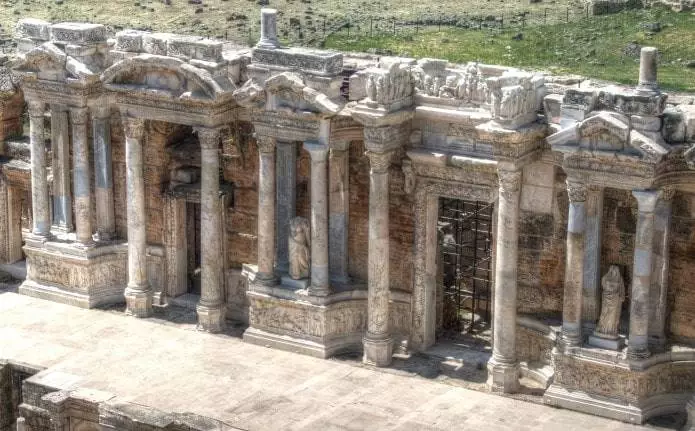
Many buildings to see from the ancient city of Hierapolis include the Byzantine walls, the Necropolis, and the Apollo temple but I was eager to see what was in my sights, the region’s queen, and that was the thermal pools.
Thermal pools at Pamukkale Hot Springs
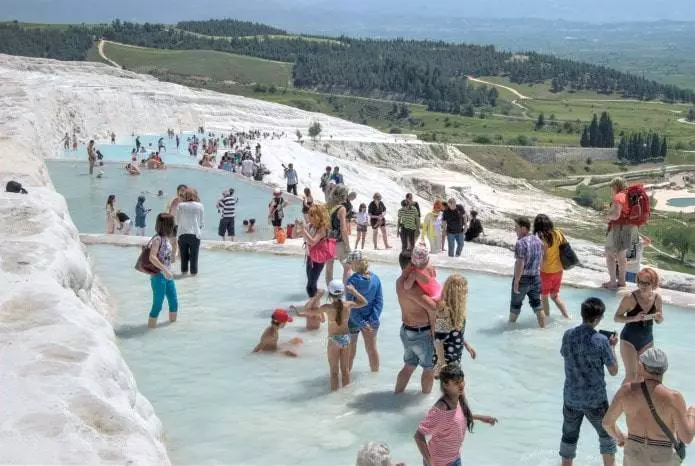
For the first time I felt like I’d visited. Everything seemed so different from when I came 13 years ago but there was something else that caught my eye. Travertines had become more dried up than water-filled ones. Three sections were spread out over the landscape before me but only the middle one was open, filled with bathers swimming and paddling in a milky white water that averages around 33 degrees of temperature. The rock leading up to the pools was a rusty-brown one and the security guard would blow their whistle every so often as people walked on with their shoes on.
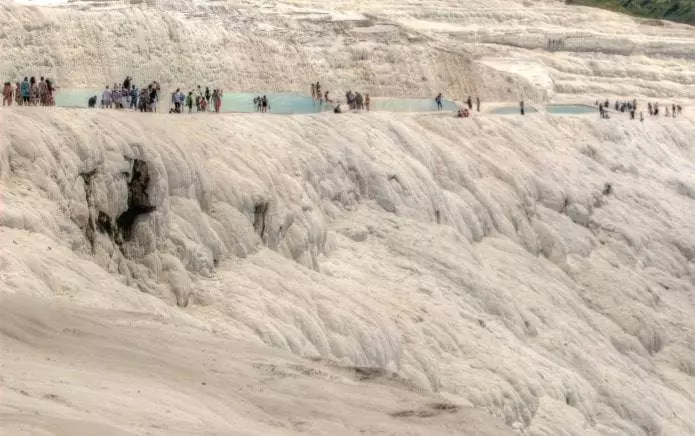
I hear someone else inquire about the dried up thermal pools for protection and the response is they shut them down for cleaning. That wasn’t sitting right with me anyhow. This is a natural landmark made from calcium carbonate deposits, which have been around for thousands of years.
It was used by Romans as a spa center because hot springs originate from the water. Since Mother Nature needed our help in preserving the earth when, unless it was we who damaged it first! Rumors of Pamukkale ‘s demise have been around for years. At one point, they were polluted by hotels backing the pools but have since been shut down. Bathing in the bath was banned at another point of time.
It is also important to note that Pamukkale and Hierapolis receive millions of visitors each year who, if they want to swim in Cleopatra’s pools, each pay 25 liras fare, 5 liras to the museum and the huge sum of 32 lira. Add to this the revenue created by the souvenir shops and restaurants on-site, and that’s a humongous amount of money going through Pamukkale.
And what the security guard was saying really in my eyes was …
“Actually, the thousands of tourists that are tramping through it every day are disrupting the ecological balance but it generates so much income that we need to keep it open.”
Though Pamukkale may not disintegrate during our lifetime, I doubt whether this marvel of Turkey will be seen by future generations.
Cleopatra’s Pool at Pamukkale
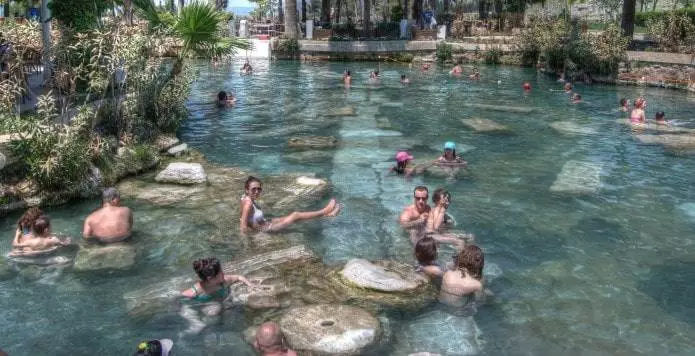
I headed to Cleopatra ‘s pool after seeing white Pamukkale, because it had restaurants and toilets. A sign at the entrance boasting of the water’s soothing qualities said it relieves symptoms of many illnesses including teenage acne, high blood pressure and varicose veins.
The cynic in me wondered if it’s just a ploy to explain the high cost of swimming in the pool, which at the bottom includes fallen columns from the ancient Roman town of Hierapolis but it was meaningless because I didn’t spend a massive sum of money just to swim.
There’s also something seriously wrong with an institution boasting of super-healing water covering ancient ruins, playing at high volume the f * * * * Macarena dance song from 2011. The atmosphere went destroyed!
It was reported that despite being one of the most beautiful landmarks in Turkey, Pamukkale has been firmly signed, caged up and sealed by the tourism seal which can make or break a destination. Tutting myself softly, I left and went to the museum on the grounds.
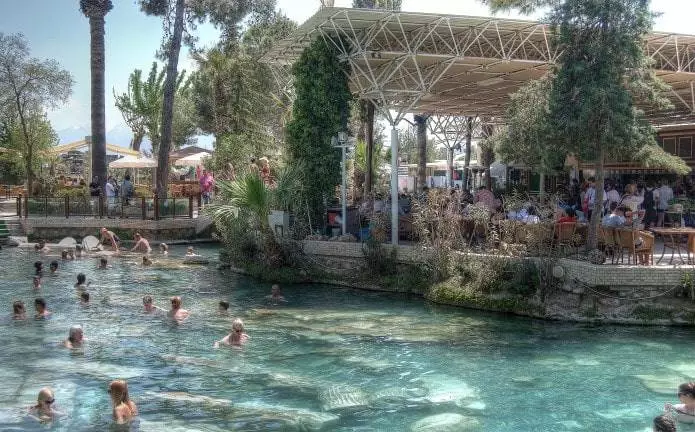
Museum of Archaeology in Pamukkale and Hierapolis
Located in 3 rooms and inside the grounds, the museum exhibits objects from Hierapolis’ ancient ruins as well as other excavated sites such as Laodicea and Aphrodisia. The most remarkable of all was the room with the sarcophagus. I felt a shame that the museum was visited by just me and four other people, while the Cleopatra’s pool was jam-packed but not everyone enjoys history, a fact that I remember every day.
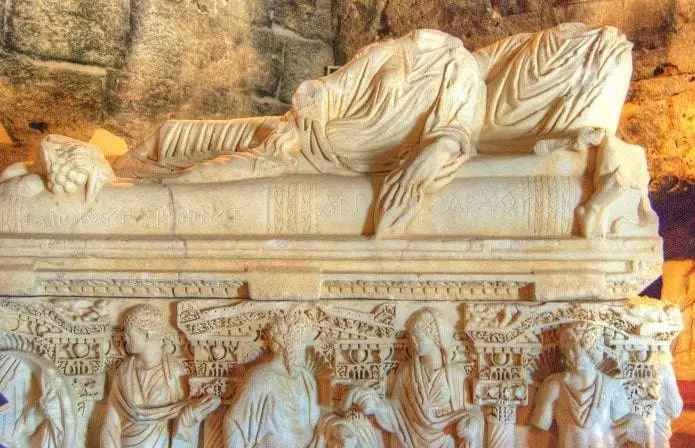
While blighted by the pitfalls of mass tourism, Pamukkale and Hierapolis are certainly a good place to visit while in Turkey, simply because it is a stunning natural and striking landmark. People can also go on a hot air balloon trip in the early morning hours, or paraglide over the travertines during the day at any time. But, instead of just stopping by for the day, live overnight because you can enjoy it a lot more.
Turkey is a place where you can find a wide range of natural attractions that nobody else in the world can see. It is easy to reconnect with nature in Turkey, with 43 national parks and 300 wetland areas. With Turkey Tour and Turkey Tour packages, come and discover the amazing natural wonders, natural protected areas, and nature parks in our country.
Explore all of Turkey’s natural beauties, such as breathtaking crashing waterfalls, magnificent mountains, idyllic Black Sea plateaus, beautiful canyons, fascinating valleys, breathtaking crater lakes, floodplain forests, majestic trees, lakes and rivers. Cappadocia Tour and Cappadocia Tour 2 days are available to guide you, visit them to explore more about Turkey its neighborhoods and its culture.



